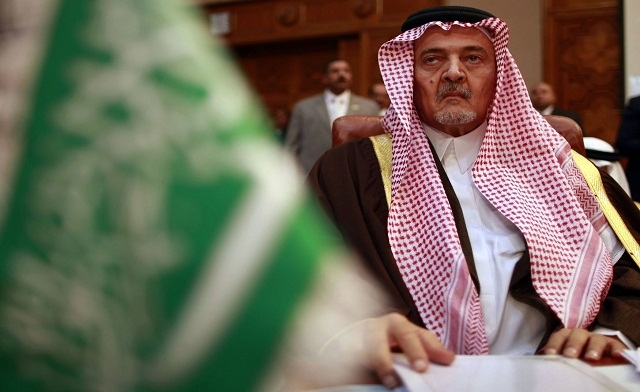PHOTO: Saudi Foreign Minister Prince Saud
Since the Assad regime’s chemical weapons attacks on August 21, we have followed two related stories — Saudi Arabia’s decision to step up support for the insurgency, even as Washington retreated from intervention and pressure on Damascus, and the consequent pursuit by Riyadh of an “autonomous” policy in and beyond Syria.
Now further information establishes how far the Saudis are going — and thus diverging from the US: the Kingdom is seeking no less than the formation of a “national insurgency”, distinct from the Supreme Military Council which had long been backed by the US.
Yet this is not a decision rooted in a long-developing split from Washington. To the contrary, the US and Riyadh should have been united in the pursuit of the military goal. It was President Obama’s sudden reversal of policy on August 31, pulling back not only from airstrikes but from any significant assistance to opposition fighters, that set this course.
On August 8, two weeks before the chemical weapons attacks, the Syrian National Coalition declared that it was working with the Free Syrian Army to form a unified force of 6,000 men to establish control in “liberated” areas.
Significantly, the declaration was made by the head of the Coalition, Ahmed Jarba, who was backed by Saudi Arabia in the leadership contest earlier this year. Coalition members said the initiative would be the nucleus of a national army with a strength of up to 10,000 troops, including 6,300 army defectors who had taken refuge in Jordan and Turkey.
The formation of the force should have been supported by the training of thousands of insurgents in Jordan, with the involvement of American as well as French and Pakistani instructors, which had been underway for several months.
But then came Obama’s statement on August 31, referring the question of intervention to Congress, and the US decision a few days later to focus on partnership with Russia, both for handover of Syria’s chemical weapons stocks and for the long-proposed but never-confirmed “peace” conference in Geneva.
Two weeks later, the Foreign Ministers of Saudi Arabia, Jordan, and the United Arab Emirates, met French President François Hollande in Paris. The Gulf States and France agreed to “step up international support for the democratic opposition to allow it to cope with attacks from the regime”.
The statement was still framed as support for the Syrian National Coalition and the Supreme Military Council, as the US pulled back, rather than as backing of a new movement. However, events — whether or not fostered by the Saudis — would quickly move on.
In the north of Syria, 13 insurgent factions declared a common bloc. While the union was motivated in part by the growing challenge of the Islamic State of Iraq and as-Sham, which had bloodily evicted a Free Syrian brigade from the town of Azaz, it was also prompted by dissatisfaction with the SNC, the SMC, and the US.
Even more importantly, more than 40 factions operating in Damascus Province announced on September 29 that they were joining forces in the fight near the capital. The new coalition, Jaish al-Islam, appeared to be led by Zahran Alloush, the Syrian Secretary-General of the Syrian Islamic Liberation Party who is based in Saudi Arabia.
Riyadh had a choice to make. Did it continue to favor the SMC or did it look to Jaish al-Islam as the new vehicle for the national insurgency? There was a hint of an answer in mid-October when a Saudi delegation returned to Paris to discuss the arming of both the Free Syrian Army and the new insurgent movement.
There are major hurdles for this national insurgency. The Saudis face a patchwork conflict in such the brigades in the north and the northeast will not necessarily link up with a Jaish al-Islam based near Damascus. Indeed, the bloc near the capital has faced fracturing. Several groups in the Syrian Islamic Liberation Front refused to join and pulled out of a joint operations room — five of them formed the Glories of Islam Assembly on October 4. Two leading factions, the al-Habib al-Mustafa and al-Sahala Brigades and Ahrar al-Sham, also stepped away. When civilian groups announced an expanded council in the Damascus suburb of Douma, Jaish al-Islam head Alloush condemned them for “dividing the voice of Muslims, which…splits the ranks”.
The Saudis also face a major logistical problem, courtesy of the Americans. The main route for supplying the southern insurgents is across the Jordanian border. However, with their tilt towards the Russians and the “peace” conference, Washington is in no mood to support the effort — and, indeed, they may be blocking it. The Jordanian establishment, anxious about any consequences within its territory of heightened intervention, is less forthcoming because of the American reluctance.
None of this means, however, that the Saudis will not make the attempt. Reports are circulating that Prince Bandar, the head of Saudi intelligence and the leading official in the Syrian effort, has been in Jordan trying to make arrangements.
Given the protracted nature of the Syrian conflict, that effort is likely to last some time. And so then will the tension in Riyadh’s relationship with the US.

